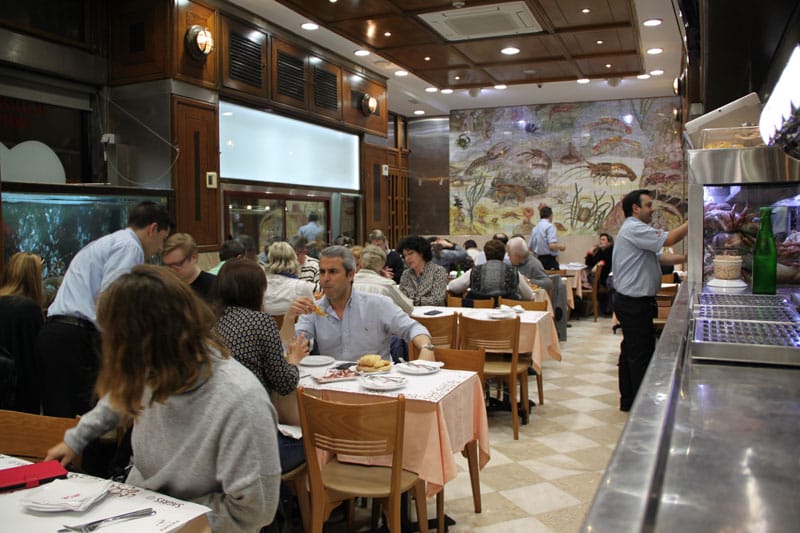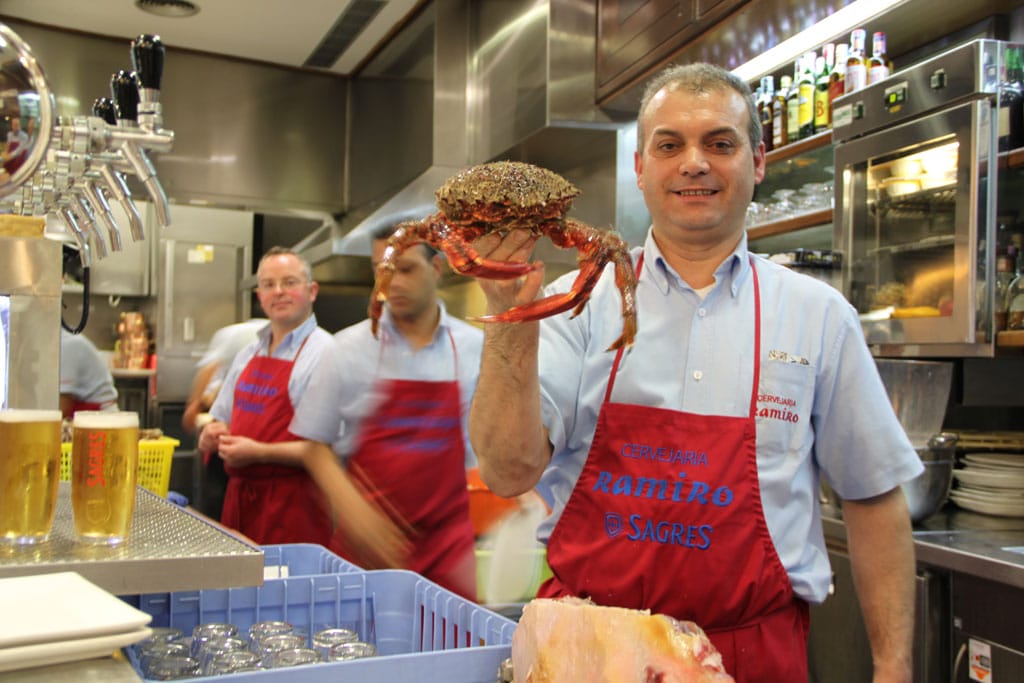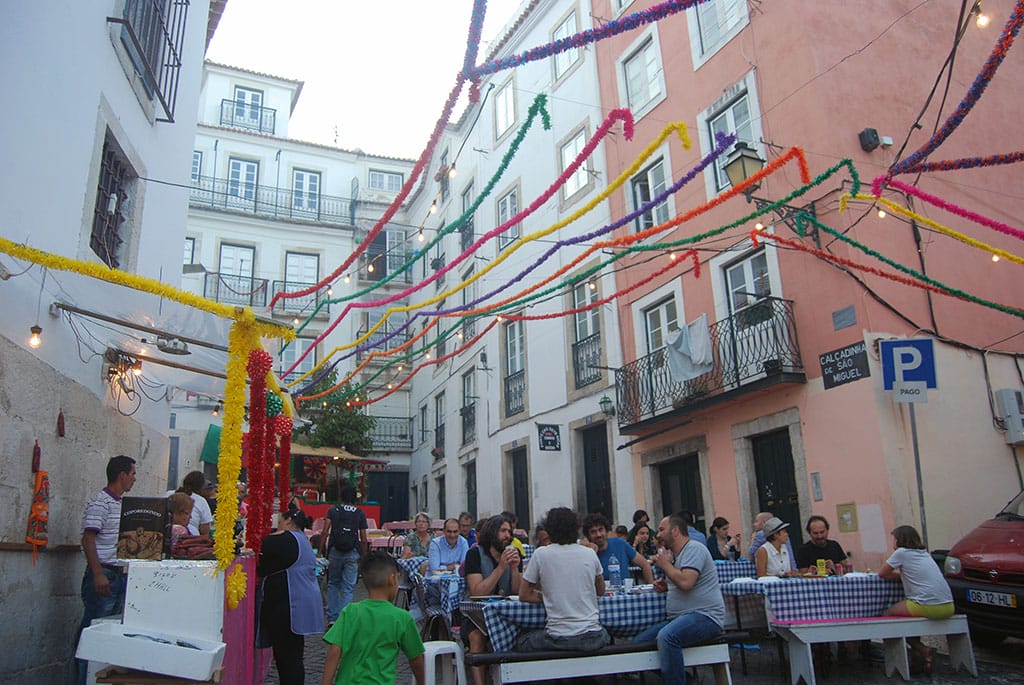Cervejaria Ramiro is the undisputed temple of seafood in central Lisbon. The 50-year-old business represents an old-school type of eatery: a beer hall where the seafood is fresh and cheap, with a choice from the daily menu or directly from the large aquariums that look out to the street.
Taking up two floors of a late-Art Nouveau building on Avenida Almirante Reis, Cervejaria Ramiro is perpetually crowded. The clientele has not been affected by the recent urban regeneration of the area, which is turning the degraded Intendente neighbourhood, long affected by social exclusion, into a fashionable district. In fact, the restaurant was already popular in the 1970s, when eating seafood was new to the capital. In those times, Ramiro – the forefather of this family business – decided to convert his modest, working-class tavern into a new trend. As a migrant from Galicia, the northwestern Spanish region where the cold water and nautical traditions made seafood a pillar of its gastronomy, he was one of the first to introduce shellfish to Lisbon – now a staple of the dining-out scene.
Ramiro is what Lisboetas call a “successful Galician,” due to his business achievements. Galician migration is not a recent phenomenon here; due to the geographical and cultural closeness, many people tried their luck in Portugal during several historical moments – particularly in the 18th century, when workers came to help reconstruct Lisbon after the earthquake, and later in the 20th century, when escaping from the Spanish civil war. Like a lot of Portuguese abroad, many Galicians dedicated their life to gastronomy, merging their traditions with local food habits.

Nowadays, there’s a never-ending queue of locals and tourists who want to try the signature fare, which includes Ramiro’s classic sapateira, stone crab stuffed with a pâté composed of its meatier parts and accompanied by a mayonnaise, egg and mustard sauce, served with crusty and buttery warm bread. Gamba á la aguilho, shrimp with garlic and pepper cooked with brandy and lemon, is another appetizing dish. But there’s a huge assortment of quality seafood, including giant Mozambican prawns, carabineiros (scarlet shrimp) and barnacles. The starter of tiny Porto shrimps, normally hard to find in Lisbon, is a must.
Another speciality of this restaurant is the ham, 5J Pata Negra, one of the most desirable hams in all of the Peninsula. It has been on the menu since the 1960s, which reflects Ramiro’s secret passion for hunting in Andalusia – the southern region of Spain abundant with black pigs.
CB’s suggested “dessert” is a heady one: the prego (a garlic-laced beef sandwich) at Cervejaria Ramiro is another icon of Lisbon, known as the most succulent of its kind in the city. “The secret of our prego is to eat it after the seafood,” says manager Pedro Gonçalves. “It ends the food journey that we provide at our restaurant, which navigates different coasts and, finally, comes back to the land.”
Decorated with marine motifs, memories of seafaring discoveries and portraits of Ramiro himself, this restaurant is characterized by a frenzy of friendly, fast waiters and loud chatter. Even though this eatery has become an obligatory listing in pretty much any food guide to Lisbon, especially after the tourist boom kicked off in 2008, it is still a reference point among locals, meaning the informal and bustling atmosphere remains intact. Far from being sophisticated, its emblematic status is due, simply, to the outstanding quality of the ingredients.
 June 11, 2015 Sardines for Santo António
June 11, 2015 Sardines for Santo António
The smell and the smoke attract us like a magnet. We can’t see them, but there are […] Posted in Lisbon March 24, 2014 Tres Leches
March 24, 2014 Tres Leches
Pastel de tres leches is beloved throughout much of Latin America, and yet its origins […] Posted in Mexico City April 3, 2023 Paris Oven
April 3, 2023 Paris Oven
Back when it was called Noisette, we'd passed by Paris Oven many times in the (not […] Posted in Queens
Published on April 07, 2016
Related stories
June 11, 2015
LisbonThe smell and the smoke attract us like a magnet. We can’t see them, but there are sardines being grilled over charcoal somewhere nearby. We are in Largo do Chafariz de Dentro, where the Fado Museum is, and the strong smell of the popular deep-fried farturas (a big churro) goes unnoticed due to the overwhelming…
March 24, 2014
Mexico CityPastel de tres leches is beloved throughout much of Latin America, and yet its origins remain a mystery. Some people claim that it was first baked in Nicaragua, others that the recipe was first printed on the label of a well-known brand of canned condensed milk in Mexico. Tres leches is usually a sponge cake soaked…
April 3, 2023
QueensBack when it was called Noisette, we'd passed by Paris Oven many times in the (not quite) year that it had been open. But whenever we’d walked down those sometimes clamorous blocks of 30th Avenue in Astoria, Queens – not far from a bagel shop, a pizzeria, a comfort-food hotspot and a New Orleans-themed bar-restaurant,…


















































































